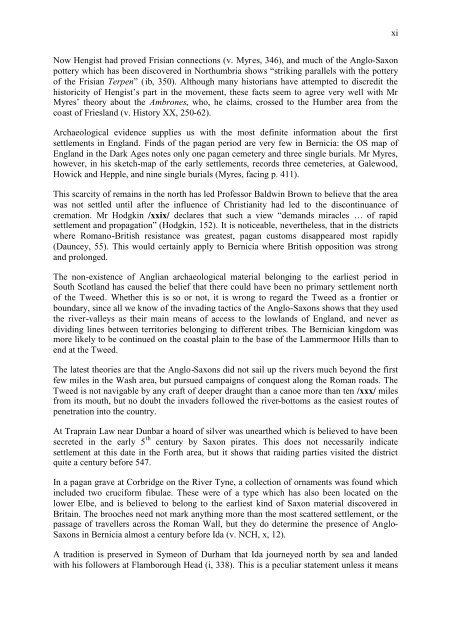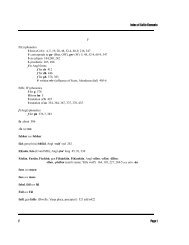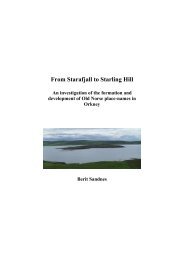May Williamson: The Non-Celtic Place-Names of the Scottish Border ...
May Williamson: The Non-Celtic Place-Names of the Scottish Border ...
May Williamson: The Non-Celtic Place-Names of the Scottish Border ...
You also want an ePaper? Increase the reach of your titles
YUMPU automatically turns print PDFs into web optimized ePapers that Google loves.
xi<br />
Now Hengist had proved Frisian connections (v. Myres, 346), and much <strong>of</strong> <strong>the</strong> Anglo-Saxon<br />
pottery which has been discovered in Northumbria shows “striking parallels with <strong>the</strong> pottery<br />
<strong>of</strong> <strong>the</strong> Frisian Terpen” (ib, 350). Although many historians have attempted to discredit <strong>the</strong><br />
historicity <strong>of</strong> Hengist’s part in <strong>the</strong> movement, <strong>the</strong>se facts seem to agree very well with Mr<br />
Myres’ <strong>the</strong>ory about <strong>the</strong> Ambrones, who, he claims, crossed to <strong>the</strong> Humber area from <strong>the</strong><br />
coast <strong>of</strong> Friesland (v. History XX, 250-62).<br />
Archaeological evidence supplies us with <strong>the</strong> most definite information about <strong>the</strong> first<br />
settlements in England. Finds <strong>of</strong> <strong>the</strong> pagan period are very few in Bernicia: <strong>the</strong> OS map <strong>of</strong><br />
England in <strong>the</strong> Dark Ages notes only one pagan cemetery and three single burials. Mr Myres,<br />
however, in his sketch-map <strong>of</strong> <strong>the</strong> early settlements, records three cemeteries, at Galewood,<br />
Howick and Hepple, and nine single burials (Myres, facing p. 411).<br />
This scarcity <strong>of</strong> remains in <strong>the</strong> north has led Pr<strong>of</strong>essor Baldwin Brown to believe that <strong>the</strong> area<br />
was not settled until after <strong>the</strong> influence <strong>of</strong> Christianity had led to <strong>the</strong> discontinuance <strong>of</strong><br />
cremation. Mr Hodgkin /xxix/ declares that such a view “demands miracles … <strong>of</strong> rapid<br />
settlement and propagation” (Hodgkin, 152). It is noticeable, never<strong>the</strong>less, that in <strong>the</strong> districts<br />
where Romano-British resistance was greatest, pagan customs disappeared most rapidly<br />
(Dauncey, 55). This would certainly apply to Bernicia where British opposition was strong<br />
and prolonged.<br />
<strong>The</strong> non-existence <strong>of</strong> Anglian archaeological material belonging to <strong>the</strong> earliest period in<br />
South Scotland has caused <strong>the</strong> belief that <strong>the</strong>re could have been no primary settlement north<br />
<strong>of</strong> <strong>the</strong> Tweed. Whe<strong>the</strong>r this is so or not, it is wrong to regard <strong>the</strong> Tweed as a frontier or<br />
boundary, since all we know <strong>of</strong> <strong>the</strong> invading tactics <strong>of</strong> <strong>the</strong> Anglo-Saxons shows that <strong>the</strong>y used<br />
<strong>the</strong> river-valleys as <strong>the</strong>ir main means <strong>of</strong> access to <strong>the</strong> lowlands <strong>of</strong> England, and never as<br />
dividing lines between territories belonging to different tribes. <strong>The</strong> Bernician kingdom was<br />
more likely to be continued on <strong>the</strong> coastal plain to <strong>the</strong> base <strong>of</strong> <strong>the</strong> Lammermoor Hills than to<br />
end at <strong>the</strong> Tweed.<br />
<strong>The</strong> latest <strong>the</strong>ories are that <strong>the</strong> Anglo-Saxons did not sail up <strong>the</strong> rivers much beyond <strong>the</strong> first<br />
few miles in <strong>the</strong> Wash area, but pursued campaigns <strong>of</strong> conquest along <strong>the</strong> Roman roads. <strong>The</strong><br />
Tweed is not navigable by any craft <strong>of</strong> deeper draught than a canoe more than ten /xxx/ miles<br />
from its mouth, but no doubt <strong>the</strong> invaders followed <strong>the</strong> river-bottoms as <strong>the</strong> easiest routes <strong>of</strong><br />
penetration into <strong>the</strong> country.<br />
At Traprain Law near Dunbar a hoard <strong>of</strong> silver was unear<strong>the</strong>d which is believed to have been<br />
secreted in <strong>the</strong> early 5 th century by Saxon pirates. This does not necessarily indicate<br />
settlement at this date in <strong>the</strong> Forth area, but it shows that raiding parties visited <strong>the</strong> district<br />
quite a century before 547.<br />
In a pagan grave at Corbridge on <strong>the</strong> River Tyne, a collection <strong>of</strong> ornaments was found which<br />
included two cruciform fibulae. <strong>The</strong>se were <strong>of</strong> a type which has also been located on <strong>the</strong><br />
lower Elbe, and is believed to belong to <strong>the</strong> earliest kind <strong>of</strong> Saxon material discovered in<br />
Britain. <strong>The</strong> brooches need not mark anything more than <strong>the</strong> most scattered settlement, or <strong>the</strong><br />
passage <strong>of</strong> travellers across <strong>the</strong> Roman Wall, but <strong>the</strong>y do determine <strong>the</strong> presence <strong>of</strong> Anglo-<br />
Saxons in Bernicia almost a century before Ida (v. NCH, x, 12).<br />
A tradition is preserved in Symeon <strong>of</strong> Durham that Ida journeyed north by sea and landed<br />
with his followers at Flamborough Head (i, 338). This is a peculiar statement unless it means




